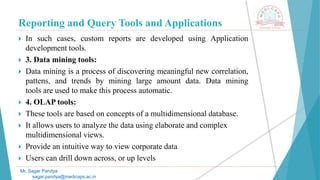This document contains information about a course on Data Mining and Warehousing taught by Mr. Sagar Pandya at Medi-Caps University. The course code is IT3ED02 and it is a 3 credit course covering 5 units: introduction to data mining, association and classification, clustering, and business analysis. It provides reference books and textbooks for the course. It also contains lecture materials from Mr. Pandya covering topics like querying and reporting tools, applications of data mining, OLAP, and OLAP cubes.





















































































